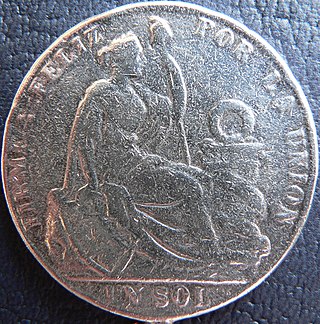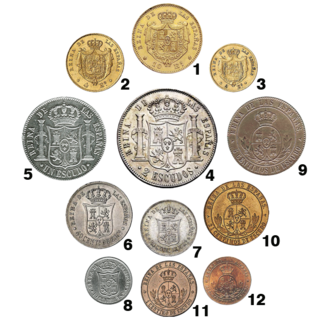
The peseta was the currency of Spain between 1868 and 2002. Along with the French franc, it was also a de facto currency used in Andorra.

The sol, later sol de oro, was the currency of Peru between 1863 and 1985. It had the ISO 4217 currency code PES. It was subdivided into 10 dineros or 100 centavos. It also had two different superunits over its circulation life, the inca (1881–1882) and later the gold pound, both worth 10 soles.
The pound is the currency of Gibraltar. It is pegged to – and exchangeable with – British pound sterling at par value. Coins and banknotes of the Gibraltar pound are issued by the Government of Gibraltar.

The rupia was the currency of Portuguese India sometime after 1668 until 1958. Prior to 1668, the currency unit was Xerafim. In 1666, the Portuguese administration struck a silver coin calling it double xerafin and this was declared equal to a rupia in circulation in India outside of Portuguese possessions. A xerafim was a convertible subunit of rupia, and it was unique to Portuguese colonies in India. One rupia equalled two xerafims.

The real was a unit of currency in Spain for several centuries after the mid-14th century. It underwent several changes in value relative to other units throughout its lifetime until it was replaced by the peseta in 1868. The most common denomination for the currency was the silver eight-realSpanish dollar or peso which was used throughout Europe, America and Asia during the height of the Spanish Empire.

The real was the unit of currency of Portugal and the Portuguese Empire from around 1430 until 1911. It replaced the dinheiro at the rate of 1 real = 3+1⁄2 libras = 70 soldos = 840 dinheiros and was itself replaced by the escudo at a rate of 1 escudo = 1000 réis. The escudo was further replaced by the euro at a rate of 1 euro = 200.482 escudos in 2002.
The franc was the currency of French Morocco from 1921. It became the currency of all Morocco in 1957 and circulated until 1974. It was divided into 100 centimes.
The rial was the currency of Morocco between 1880 and 1921. It was subdivided into 10 dirham, each of 50 mazunas.

The peso was the currency of Nicaragua between 1878 and 1912. It was Nicaragua's first national currency, replacing the Central American Republic real and that of neighbouring states. It was subdivided into 100 centavos and when it was introduced, it was worth 8 reales, and had the same weight and mass as the peso fuerte, but due to recurrent devaluations, it was replaced by the córdoba at a rate of 12+1⁄2 pesos = 1 peso fuerte = 1 córdoba.

The peso was a currency of Venezuela until 1874. It was subdivided into 10 reales, each of 10 centavos.

The sol was the currency of Bolivia between 1827 and 1864. There were no subdivisions of the sol but 16 soles were equal to 1 escudo. The sol replaced the real at par and was replaced by the boliviano at a rate of 8 soles = 1 boliviano. Only coins were issued.

The real was the currency of Colombia until 1837. No subdivisions of the real existed until after the real had ceased to be the primary unit of currency. However, 8 reales = 1 peso and 16 reales = 1 escudo.

The peso was a currency of Ecuador until 1884.

The real was the currency of Peru until 1863. Sixteen silver reales equalled one gold escudo. The silver coin of 8 reales was also known as the peso.

The escudo was either of two distinct Spanish currency denominations.
In 1847, the Kingdom of Hawaiʻi, under the reign of King Kamehaheha III, issued its first official coinage—a large one-cent copper penny—to alleviate the chronic shortage of small denomination coins circulating in the Hawaiian Islands. The next and last official coinage of the Hawaiian Islands was minted in 1883, by King Kalākaua I; however during the intervening period, the changing needs of the Hawaiian Islands were met by circulating private-issued tokens and the coins of the United States of America.

The Peruvian gold pound, was a unit of currency issued in Peru between 1898 and 1931. It was fixed in value to 10 soles de plata and was issued in the form of gold coins and banknotes, which circulated alongside coins denominated in centavos, dineros and soles. The gold pound was equal to the British sovereign.

The currency of Venezuela has been in circulation since the end of the 18th century. The present currency unit in Venezuela is the Venezuelan bolívar.
Currency in Colombia denotes the ingots, coins, and banknotes that have been used in Colombia since 1622. It was in that year, under a licence purchased from King Philip III of Spain, that Alonso Turrillo de Yebra established a mint at Santa Fe de Bogotá and a branch mint at Cartagena de las Indias, where gold cobs were produced as part of Colombia's first currency. Silver milled coins date from 1627. In 1831, Gran Colombia dissolved into Venezuela and New Granada. In 1836, in New Granada, new monetary laws were passed, to standardise the money produced in the country. From 1861 to 1862, due to financial instability, the United States of New Granada accepted British currency, the name of the country becoming the United States of Colombia in 1862. In 1880, Colombia pegged the peso to the gold standard due to the falling price of silver. In 1886, the paper peso was introduced. In 1931, Colombia abandoned the gold standard and switched to the current form of the peso.
This article provides a historical summary of the currency used in Ecuador. The present currency of Ecuador is the United States dollar.














